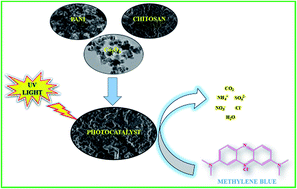Synthesis of chitosan grafted-polyaniline/Co3O4 nanocube nanocomposites and their photocatalytic activity toward methylene blue dye degradation†
Abstract
In the present investigation, chitosan-grafted-polyaniline copolymer (ChGP) and Co3O4 nanocube-doped ChGP nanocomposites have been successfully synthesised via oxidative-radical copolymerisation using ammonium persulfate in an acidic medium for the photocatalytic degradation of methylene blue dye. The prepared nanocomposites were characterised by field emission scanning electron microscopy (FESEM), transmission electron microscopy (TEM), thermogravimetric analysis (TGA), X-ray diffraction (XRD), UV-vis spectroscopy, X-ray photoelectron spectroscopy (XPS) and Fourier transform infrared spectroscopy (FTIR). FESEM and TEM images confirmed the formation of Co3O4 nanocubes and a crosslinked polymeric network. The photocatalytic activities of ChGP and Co3O4 nanocube-doped copolymers were evaluated by monitoring the degradation of methylene blue dye under UV illumination. The degradation efficiency of the copolymer photocatalysts that were doped with Co3O4 nanocubes was higher than that of the undoped copolymer. Furthermore, the nanocomposite with 2 wt% Co3O4 nanocubes with respect to aniline was an optimum photocatalyst, with an 88% degradation efficiency after 180 minutes of irradiation under UV light.



 Please wait while we load your content...
Please wait while we load your content...